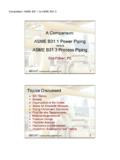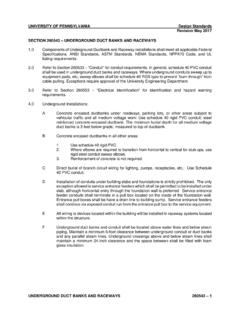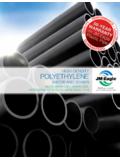Transcription of Session 13 –Wiring Methods & Cable Standards
1 Session 13 Wiring Methods & Cable StandardsMulticorecables on racks or trays may be bunched in a maximum of two and LV single core cables shall be laid in trefoil groups with 150 mm clear spacingbetween trays or racks HV cables shall be segregated from the LV cables. Individual cables emerging from floors or soil shall be protected against mechanical damage by means of galvanized steel pipes or rigid PVC pipes. Single core cables emerging from floors or soil shall be protected by rigid PVC pipes. These pipes shall extend at least 100 mm above ground or floor cables emerging from floors or soil shall be protected collectively by a properly designed metal shield or duct in such a way that heat dissipation of the sustained load carrying cables is not hampered.
2 The propagation of fire from one space to the other shall be prevented by proper sealing of openings around or Cable supports shall not be fixed directly or indirectly to plant, equipment or process piping which may require removal or replacement. Cables shall be laid on racks or trays strictly in accordance with the laying patterns stated on the layout drawings. Metal parts of the Cable racks and trays shall be bonded and connected to the common IEC Wiring SpecificationTypical IEC Wiring SpecificationBends and corners in the Cable racks, trays or ladders shall take account of the minimum Cable bending radii.
3 Cable racks and trays shall be closed by removable top covers, allowing adequate ventilation, in situations where: mechanical damage of the cables is likely to occur during plant maintenance activities, oil or chemical spillages on the trays can be expected, sun shielding is required against direct solar Cable rack risers shall not be installed in front of, or over, pipe cablingThe application of flexible cables in industrial plants and installations shall be limited to: welding cables; trailing cables, for movable equipment, hand tools, hand lamps; winches, hoists, soot blowers, and electric motors, if connected by means of a nearby intermediate junction earth continuity conductor, equal in cross sectional area to the largest phase conductor, shall be provided.
4 This requirement applies even when the Cable is IEC Wiring SpecificationCable marking/numberingCable numbers shall be marked on the cables along their routes and at both termination points. For underground cabling, the spacing between Cable numbers along the route should not exceed 5 m, and for above ground cabling, 25 m. Cables shall also be numbered where they branch off from a main underground Cable marking purposes non corroding strips shall be used, each having ample length to be wrapped twice around the Cable and in which the Cable number has been imprinted by means of letter/cipher punches.
5 For above ground cabling, plastic markers resistant to the site conditions shall be strapped round the underground cabling, above ground route markers shall also be provided at every change of direction in the routing and at both sides of road or pipeline crossings, except when Cable routing is already indicated by colored concrete Installation MethodsConduit or Cable Entry via EEx e gland & enclosureDirect Entry via EEx d conduitDirect Entry via EEx d glandTypical Wiring MethodsRigid ConduitUnarmoredCableArmoredCableIEC Cable Types and ConstructionUnarmored Cable similar to US TC type cables but with fully extruded fillers.
6 Armored Cable similar in concept to IEEE45 Type P marine shipboard Cable and continuous corrugated aluminum armor SWA Steel Wire ArmorType STA Steel Tape ArmorType SWB Steel Wire BraidThe following main requirements are listed in the EN60079 standard for cables and conductors: use only insulated cables and conductors (test voltage 500 VAC), in special cases earth the required screening only once at the end of the non explosive environment, protect intrinsically safe circuits against external electrical or magnetic fields through the maintenance of adequate distances, screening and/or core twisting, isolate intrinsically safe cables and conductors from non intrinsically safe cables and conductors or, protect against mechanical damage or, protect through metal housing.
7 Or screening of the cables and conductors do not combine conductors of intrinsically safe and non intrinsicallysafe circuits prevent the fraying of fine wired conductors through the use of Cable sleeves, for example: isolate intrinsically safe and non intrinsically safe circuits in Cable bundles or ducts via insulation spacer or an earthed metal spacer (not required with screening or sheathing), identify ( light blue) the cables and conductors of intrinsically safe circuits (not required with shielding or metal sheathing) Cable /Conductor Requirements in Zone applicationsWhen selecting cables and conductors, only use those which can withstand the expected mechanical, chemical and thermal influences.
8 Cables and conductors with thermoplastic sheath, duroplasticsheath, elastomersheath or mineral insulation with metal sheath may be used for fixed routing. Cable branch lines must comply with the requirements for hazardous cables and conductors must be connected to the electrical equipment in line with the directives for the associated type of protection. Unused openings on devices and equipment must be closed. When cables and conductors are installed through openings into non hazardous areas, care must be taken to provide an adequate seal at the openings ( sand filling, mortar) to prevent carrying over of the zone.
9 At particularlyhazardous points, cables and conductors must be protected against thermal, mechanical or chemical stress by, for example, conduits, tubing or covers. The flame retardanceof cables and conductors for fixed routing must be proven in accordance with IEC 60332 Requirements in Zone applicationsIEC Cable Types and ConstructionIn general, SWA Cable has been the Cable of choice in the UK for onshore installations. It is somewhat flexible, readily available and has good bending Cable has become the choice for installations offshore with various armor materials including tinned copper, bronze and other materials.
10 Very flexible yet durable under very demanding conditions. Many different jacket types is more of an onshore type Cable and is widely used in onshore applications in continental Europe, especially for power applications. Clients have started to shy away from STA as it is generally regarded as slightly more difficult to terminate than either SWA or variation commonly used for direct bury applications is a Lead sheathed armor Cable . Lead provides a very good insulation due to corrosive elements and is particularly resistant to rodents and ants.




![[Pick the date] - Con Ed](/cache/preview/f/d/a/4/2/3/c/f/thumb-fda423cf1f04d7b9050c19868ca969fb.jpg)
